The crib: a medieval custom still very much alive in Provence
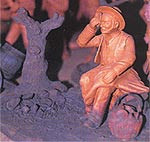
Santon fairs are held throughout Provence from mid-November (the one in Marseille dates back over 150 years! ), exhibitions of nativity scenes from all over the world and France's best santonniers d'art in Sisteron, living nativity scenes (in Aubagne), laser nativity scenes (in Allauch), santons bearing the likenesses of local villagers (in Grambois), the Route des Crèches from Manosque to Esparron du Verdon and even a contemporary nativity scene created by an artist from Nice... This December, the whole of Provence is getting ready to celebrate Christmas!
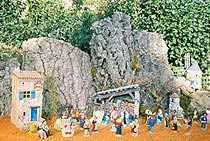
While we don't know exactly where the word "crèche" (= crib in French) comes from - German "Krippe", Provençal "grupi", patois "crupio"? - However, we can say that the tradition of the crib originated in the Middle Ages, when it was invented by Saint Francis of Assisi in Italy in the 13th century, before spreading to Provence in the early 14th century.
Similarly, the Italian "santoni" (little saints) became Provençal "santouns" when they arrived in Marseille. Originating in Italy, the first nativity scenes were originally intended for churches and were made up of very simple figures in boiled paper or plaster, representing the Virgin Mary and the Saints, the Pope as well as monks, bishops and cardinals.
When the crib became “provencal”
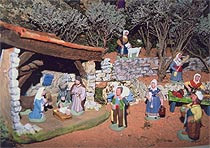
It was in Marseille that the crib became "Provençal" and private. Very quickly, the Provençal people adopted this foreign tradition, replacing the saints with characters closer to them, representing the typical characters of their villages: the Ravi and the child thief, the Blind Man and his son, Pistachié and Jiget (two farmhands intended to make people laugh), the Old Men sitting on their bench...
Not forgetting all the small trades of the time, the shepherd and the baker with his basket of fougasses, the garlic seller and the fishmonger, the farmhands carrying lanterns, the fisherman with his net over his shoulder, the woman with a jug full of fresh water...
Long displayed in churches, the Provencal crib entered every home at the end of the 18th century. During the Revolution, when midnight mass and the nativity scene were banned, the people of Marseille took the initiative and set up private nativity scenes in their homes.
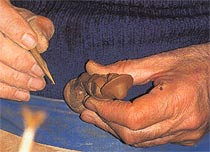
It was a Marseillais, Jean-Louis Lagnel, who made the first clay santon around 1800 - until then, the figures had been made of wood, wax, glass or earthenware. It was also in Marseille that the first santon fair was held, in the middle of the 19th century.
A fair that still exists today, just as it is still from a handful of red clay that the santon-maker models and sculpts the body, clothes and accessories that personalise each santon, which is then dried, baked and painted with gouache.
Aubagne, birthplace of Marcel Pagnol and capital of santons.
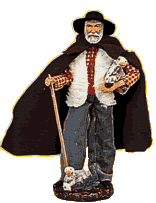
In addition to these clay santons, it is also traditional to make 'dressed' santons, which are generally larger and more upmarket, such as those made by Raymond and Sylvette Amy, craftsmen in Aubagne since 1966: while Raymond models and sculpts the clay to give it the shape of a body and the delicate expression of a face, Sylvette cuts, trims and sews the fabrics to create the Provençal costumes, in the style of the 19th century, that will dress the santons.
In fact, Aubagne has become the santon 'capital' of Provence, thanks to the ancestral skills of its master santon-makers.
The oldest workshops, renovated in 1995, still exist under the name "Ateliers Thérèse Neveu". Born in 1866 into a family of ceramists, Thérèse Neveu lived in Aubagne, where this "grande dame of clay" was the first to practise the trade of "santonnier", inventing the technique of firing pieces that until then had been raw and dried in the sun, and "santonnifying" the town's notables.
Aubagne also hosts an annual santon and ceramics fair, where you can admire a giant crib, the collective work of Aubagne santon-makers, with more than 150 subjects, not to mention a biennial santon art festival (the next will be held in 2004).
Three contemporary and original Provencal cribs
Patrick Moya's ctib, Galerie Ferrero, Nice.
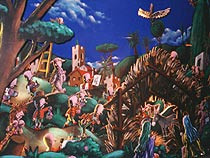
Patrick Moya is a talented artist from Nice who plays with the four letters of his name and represents himself everywhere in his work, in the guise of a little comic strip character, a hybrid between his self-portrait and Pinocchio.
For Christmas 2003, to liven up the window of the Ferrero art gallery (famous in Nice for championing the École de Nice for 30 years), he presented a nativity scene in his own style.
Reinterpreted by Patrick Moya, the crib becomes a work of art made up of a sumptuous décor painted in the colours of the south (blue sky and umbrella pines) and a multitude of small "santons" cut out of wood and coated with gouache, which represent - always in the artist's own likeness - the traditional Three Kings, the ox and the donkey, the shepherd and the Ravi, as well as modern-day characters such as the businessman and the worker, the photographer and the painter with his easel, the musician and the man of the cloth, They represent the traditional Magi, ox and donkey, shepherds and Ravi, as well as modern-day characters such as the businessman and the worker, the photographer and the painter with his easel, the musician and the cook with his steaming pan, the Devil and his lawyer, the schoolboy and his dunce cap, not forgetting the angels and the pink teddy bears...
The Pierre Graille crib in Grambois.
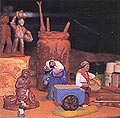
It's in Grambois, in the Vaucluse, that the famous santonnier Pierre Graille has for years been reproducing the people of his village, as well as celebrities such as François Mauriac or Paul Préboist... in the form of finely modelled and sculpted statuettes dressed in period costumes.
Every year, Pierre Graille's nativity scene is the work of a sculptor, a ceramist and a santon-maker - not to be missed!
Great actors "santonnified" by Daniel Scaturro in Aubagne
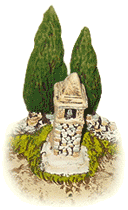
Born in Aubagne in 1954, Daniel Scaturro fell into clay when he was a child, as his father Joseph used to make nativity scenes. Today, he is renowned for his range of santons, from classic nativity figures to film characters, as well as individual, commissioned representations based on photographs.
Voted "Meilleur ouvrier de France" in 1997, his work is meticulously crafted, and he strives to transcribe every detail to give his "santouns" a little more life and soul, with stunning realism.
In particular, you'll admire "le Papet" played by Yves Montand, Don Camillo played by Fernandel and the famous "Partie de cartes" from Marcel Pagnol's film "Marius". But also Jean Gabin, Louis de Funès, Pierre Tchernia, Marcel Pagnol...
Not forgetting a French President, Jacques Chirac, who was "santonnified" by the Master!
Visit its small museum, created in 1989, where you will discover several large cribs, some of which contain santons dating back to the very beginning of the century and made by Thérèse Neveu.

